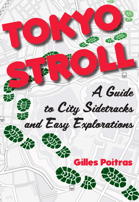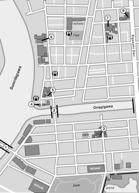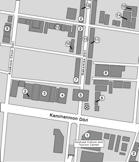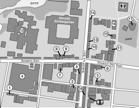











Tokyo Stroll Supplement: Shinagawa Ku

This page is for locations in the Shinagawa Ku area of Tokyo. This neighborhood is not part of my book Tokyo Stroll.
For information on Tokyo Stroll andthis web supplement see Tokyo Stroll Supplement home page
For users of the Organic Maps, Maps.Me and Google Maps apps the items below have bookmarks you can import into those apps to make navigation easier.
Instructions and links are on the Viewing Locations in Organic Maps, Maps.Me, Google Maps, or Google Earth page.
Some entries on this page may include a note that says "Description to be added soon ." These entries are for items I felt should be listed even if the description is not ready to assist those who wish to plan a trip. When possible I included a link to an official web page, I suggest also doing web searchs for more information.
Shinagawa ku (品川区)
This part of Tokyo is named after the Shinagawa post station town which was on the Tōkaidō heading west out of Edo. The present Shinagawa Ku was formed in 1947 by the merger of the older wards of Shinagawa Ku and Ebara Ku. In the late 19th century this area became a significant location for new industries, today east Shinagawa Ku continues to be an important part of the Tokyo Port facilities. Many large condo and apartment complexes have been built here, and numerous rail lines make this area accessible from various other parts of the great Tokyo area adding to the desirability of it being a place to live. To the west is Meguro ku, to the south is Ōta ku, Tokyo Bay is on the east and to the north is Minato ku.
NOTE: Shinagawa Station is not in Shinagawa Ku, rather it is just north of Shinagawa Ku in Minato Ku
Official pages for each of the ku of Tokyo will have sections of interest to visitors. These will likely be labeled as dealing with culture, tourism, or events.
Shinagawa-ku official site: https://www.city.shinagawa.tokyo.jp
Children's Forest Park / Kodomonomori Kōen (子供の森公園)
Description to be added soon
NEAREST TRAIN/SUBWAY STATION: Shimbamba Station (Keikyū Main Line), Ōsaki Station (JR Yamanote Line, JR Saikyō Line, JR Shōnan-Shinjuku Line, Tokyo Waterfront Area Rapid Transit Rinkai Line)
Ebara Shrine / Ebara Jinja (荏原神社)
Description to be added soon
NEAREST TRAIN/SUBWAY STATION: Shimbamba Station (Keikyū Main Line)
WEB: http://ebarajinja.org/top.html
Hōnsenji (品川寺)
Description to be added soon
NEAREST TRAIN/SUBWAY STATION: Aomono-yokochō Station (Keikyū Main Line)
WEB: http://honsenji.net
Hebikubo Shrine [Kamishinmeitenso Shrine] / Hebikubo Jinja [Kamishinmeitenso Jinja] (蛇窪神社 [上神明天祖神社])
Description to be added soon
NEAREST TRAIN/SUBWAY STATION: Nakanobu Station (Tokyu Ōimachi Line, Toei Asakusa Line)
WEB: http://hebikubo.jp
Ikedayama Park / Ikedayama Kōen (池田山公園)
Originally part of the suburban residence of the Ikeda clan of Okayama. The park is built on a hillside with a resting area at the top. The lower area that has a small waterfall and pond, is good for strolling. The pond has the usual koi and turtles that fit in well with gardens. The garden has a good variety of flowering and fruit bearing trees.
NEAREST TRAIN/SUBWAY STATIONS: Gotanda Station (JR East Yamanote Line, Tōei Asakusa Line, Tōkyū Ikegami Line), Shirokanedai Station (Tokyo Metro Namboku Line, Tōei Mita Line) and Takanawadai Station (Tōei Asakusa Line).
Irugi Shrine / Irugi Jinja (居木神社)
Description to be added soon
NEAREST TRAIN/SUBWAY STATION: Ōsaki Station (JR Yamanote Line, JR Saikyō Line, JR Shōnan-Shinjuku Line, Tokyo Waterfront Area Rapid Transit Rinkai Line)
WEB: https://irugijinjya.jp/
MIRAI STORE TOKYO
The shop for the Smart Doll line of high quality customizable dolls. The dolls come in a variety of skin tones and even have dolls of amputees, or with vitiligo, birthmarks, burn scarring, cleft lips, and medical devices. Such dolls have been well received by customers with similar conditions. Some doll designs even go out of production to be replaced with new ones. They not only sell the dolls but also clothing and a large variety of parts, to customize details such as bust size or hands. there are several options for hair color, style and length.
NEAREST TRAIN/SUBWAY STATION: Gotanda Station (Yamanote Line, Toei Asakusa Line, Tōkyū Ikegami Line)
NOTE:
It is worth reading the essays on the store website as this is not a conventional mass production company and that can be a fascinating thing. They even list reasons not to buy their dolls as these products are not for everyone.
CLOSED: Weekends and public holidays
WEB: https://info.smartdoll.jp/en/posts/mirai-store-tokyo
Namidabashi(泪橋)
The official name of this bridge is Hamagawabashi (浜川橋). However in the Edo Period it gained the name of Namidabashi which means bridge of tears as prisoners were taken across it on the way to the execution grounds. This Namidabashi is not to be confused with the other Namidabashi in the Sanya area of Tokyo which I describe in the Arakawa ku page.
NEAREST TRAIN/SUBWAY STATION: Tachiaigawa Station (Keikyū Main Line)
St. Anselmo Catholic Meguro Church / Hijiri Anserumo Katorikku Meguro Kyōkai (聖アンセルモ カトリック目黒教会)
Description to be added soon
NEAREST TRAIN/SUBWAY STATION: Meguro Station (JR Yamanote Line, Tokyo Metro Namboku Line, Toei Mita Line, Tokyu Meguro Line)
WEB: https://new.catholicmeguro.org
Shinagawa Aquarium (しながわ水族館)
Opened 1991 in a large community park this two story facility has been popular. There you will find penguins, dolphins, spotted seals, sea lions, otters, lots of fish and other sea life. There are numerous displays dealing with marine ecology. Perhaps the most photographed part is the tunnel water tank surrounded by sealife. For food there is the Dolphin Cafe on a wood deck, outside the paid area is the Dolphin Restaurant, which is next to the water. The Marine Shop Seagull gift shop is also outside the aquarium.
NEAREST TRAIN/SUBWAY STATION: Ōmorikaigan Station (Keikyū Main Line)
WEB: https://www.aquarium.gr.jp
Shinagawa Shrine / Shinagawa Jinja (品川神社)
Description to be added soon
NEAREST TRAIN/SUBWAY STATION: Shimbamba Station (Keikyū Main Line), Kitashinagawa Station (Keikyū Main Line)
WEB: https://shinagawajinja.tokyo
Suzugamori Execution Ground (鈴ヶ森刑場)
This execution ground was established 1651 on the Tōkaidō, the major costal road to Kyoto from Edo. Estimates of the number of those executed here range from 100,000 to 200,000. After execution the heads of the prisoners would be displayed as a warning to others. One of the leaders of the Keian Uprising, Marubashi Chūya, was the first to be "executed" here, actually he was already dead but his head was displayed here. Other famous persons included Yaoya Oshichi who was burned at the stake for arson, and according to legend Ten'ichibō who tried to pass himself off as a son of the shōgun. As this was one of the major execution grounds many other famous prisoners were killed here, bot historical and fictional. Fans of kabuki would recognize many of the names as plays were written about some of the famous cases or the execution ground is the setting of a scene. On the remaining grounds you can see the stone bases for the posts used in crucifixion, square, and burning at the stake, round. Christians were also executed near here at Edo Bay by being tied upside down to pillars at low tide to be drowned when the tide rose. The execution ground closed in 1871.
NEAREST TRAIN/SUBWAY STATION: Ōmori Station (Keihin-Tōhoku Line), Ōmorikaigan Station (Keikyū Main Line), Tachiaigawa Station (Keikyū Main Line)
Taikyōji (鈴森山大経寺)
A Buddhist temple founded around the same time as the establishment of the Suzugamori Execution Ground, it is just north of the grounds. The present building is very modern in design and many non-Japanese would not recognize it as a temple.
NEAREST TRAIN/SUBWAY STATION: Ōmorikaigan Station (Keikyū Main Line)
WEB: https://daikyoji.jp/index.html
Togoshi Ginza Shopping Street / Togoshi Ginza Shōtengai (戸越銀座商店街)
Description to be added soon
NEAREST TRAIN/SUBWAY STATIONS: Togoshi-Ginza Station (Tokyu Ikegami Line), Togoshi Station (Toei Asakusa Line)
WEB: http://www.togoshiginza.jp
Tōkaiji (東海寺)
Description to be added soon
NEAREST TRAIN/SUBWAY STATION: Shimbamba Station (Keikyū Main Line)
Tokyo Central Wholesale Market Meat Market / Tōkyō To Chūō Oroshiurishijō Shokunikuichiba (東京都中央卸売市場食肉市場)
Description to be added soon
NEAREST TRAIN/SUBWAY STATION: Shinagawa Station (JR Tokaido Shinkansen, JR Keihin–Tōhoku Line, JR Tōkaidō Line, JR Yamanote Line, JR Yokosuka Line, Keikyu Main Line)
WEB: https://www.shijou.metro.tokyo.lg.jp/info/02/
WHAT Museum
Description to be added soon
NEAREST TRAIN/SUBWAY STATION: Tennōzu Isle Station (Tokyo Monorail Haneda Airport Line, Tokyo Waterfront Area Rapid Transit Rinkai Line)
WEB: https://what.warehouseofart.org/en/
Back to the Tokyo Stroll Supplement home page - Privacy Notice - Back to Gilles' home page
Created October 19, 2022 | Content last updated August 13, 2025